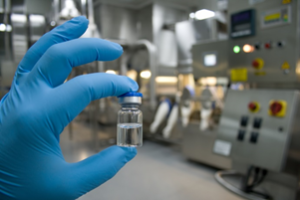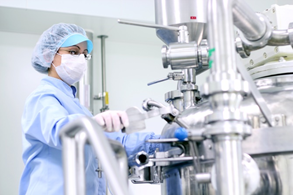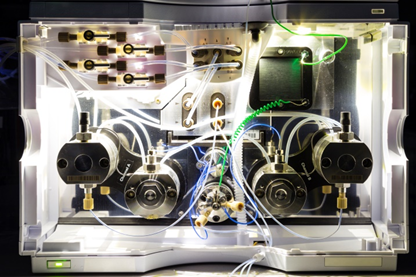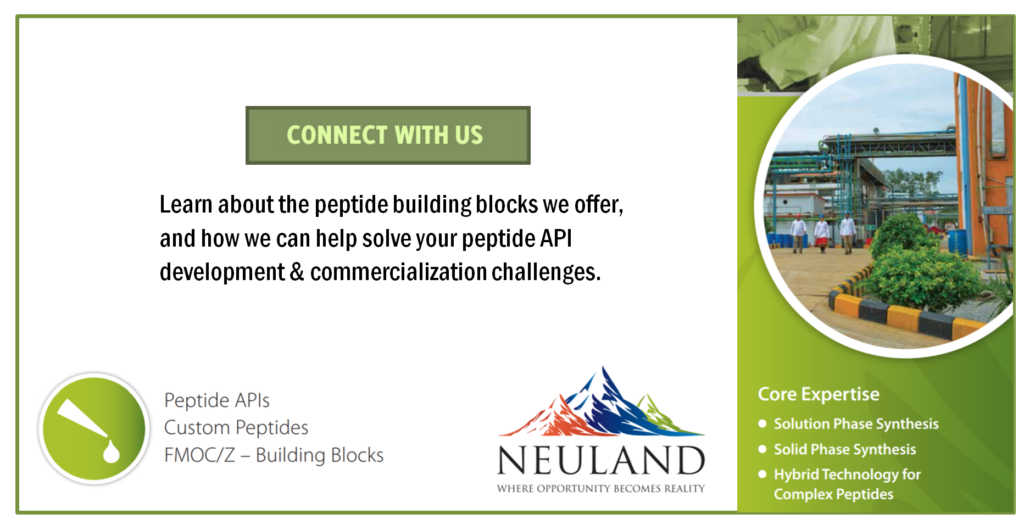Rise of the Peptide Era
Peptide synthesis has a long pharmaceutical history, stretching back to the early 1900s – and then followed by a lengthy period of dormancy. From sciencedirect.com:
“Starting about a century ago (World War I), the advent of the modern drug era came with pioneering therapeutic compounds like the opiate morphine and the cyclic peptide penicillin, followed in the early 1920s by the (poly)peptide insulin. These drugs introduced a new standard in disease treatment. Although peptides thus held their place among the initial therapeutic discoveries, small molecules rapidly took preference in the drug development industry.”
Only recently have peptides gotten another look – and the pharma industry is seeing significant potential. In its most recent market report, Grandview Research estimated the peptide therapeutics market will reach nearly $50 billion. Of particular interest is what is driving the growth:
“Technological advancements in peptide manufacturing processes are one of the major factors driving the market growth during the forecast period. Manufacturers and suppliers are focusing on the adoption of novel technologies to manufacture efficient drug molecules with low time and capital investment. Improvement in purification & automation process and less generation of waste is an additional factor attributing toward market growth.”
Decreasing Barriers to Peptide Therapeutics _________________________________________
For peptide drugs, the list of barriers to entry have always seemed formidable:
- high production cost & infrastructure requirements
- rapid degradation profiles in the human body
- corresponding lack of oral dosing delivery mechanisms
- other pharmacodynamic limitations (short half-life, high hydrophilicity, rapid hepatic clearance, etc.)
These challenges all conspired to render the peptide class promising – but ultimately unrealizable.
It’s a far cry from the early days of pharma, when peptide-based compounds like penicillin, cyclosporine, and insulin first rose to prominence. Fast forward several decades – what exactly has changed to make peptides suddenly attractive as a therapeutic class?
 The changes have come about due to a collection of advances in chemistry, biology, genomics, dosage formulation, combined with rapid shifts in our understanding of human health and exponential improvements in technology (from computational power & informatics to spectrometry, imaging and more).
The changes have come about due to a collection of advances in chemistry, biology, genomics, dosage formulation, combined with rapid shifts in our understanding of human health and exponential improvements in technology (from computational power & informatics to spectrometry, imaging and more).
Over the last two decades, we’ve seen sufficient advances in these different but interrelated areas begin to converge, enabling not a rethinking of peptides but rather the realization of their known benefits & potential.
These developments fall into three (very) broad categories:
- Synthetic Chemistry
The emergence of synthetic peptide production offers significant advantages over more costly recombinant techniques, including a much wider diversity of chemical peptides and far more economical production. The use of SPPS to produce larger, more complex peptides – in tandem with hybrid techniques that combine solution phase and solid phase methods – has broadened the landscape of peptide opportunities considerably. - Peptide Development & Drug Delivery
Peptide design complexity has also increased: developments in peptide drug conjugates, peptidomimetics and more have improved peptide degradation profiles and extended bioavailability – enabling a wider range of delivery options. Chemistry advances have also played a key role, and the chemical structure of peptides is often optimized for therapeutic use (e.g., replacing peptide bonds).Developments in the broader field of drug delivery have come into play with peptide-based therapeutics, as well. This includes alternate routes of administration being improved or developed. Peptides are lending themselves well to controlled release techniques, and exploration of non-parenteral dosing continues to expand and demonstrate viability.A number of strategies to extend bioavailability have been successfully deployed, including:
Mucosal: use of nasal sprays and sublingual use
Oral: coatings are used to protect the active substance from digestion in the stomach, or to protect the peptide against peptidases
Transdermal: patches have been successfully developed
- Commercial Peptide Manufacturing
Peptide manufacturing has become much more cost-efficient and capable, especially since the emergence of synthetic peptides. The push continues: peptides will continue to get larger, and cost efficiencies will continue to improve.Peptides as a rising therapeutic option are an excellent example of the slow, ponderous shift of science and technology. It was common in the early 2000s to point to a single type of science – genomics, for example, or proteomics, or informatics – and proclaim each one as the key paradigm shifter. None of them, alone, ever lived up to the hype as ‘The Science That Would Change Everything.’ But I would argue that each one has contributed to our general understanding – unlocking the next door, and opening up new opportunities.
Finding the Right Peptide Synthesis Technique__________________________________________
Peptides are a complex drug class, and have historically proven challenging from a manufacturing standpoint. They are, however, experiencing a renaissance due to improvements in peptide synthesis, the development of high-throughput approaches and various innovations to overcome some of their traditional limitations, such as stability and half-life. These advances are expected to drive the peptide drug market to over $48 billion by 2025.
Most peptides between five and sixty amino acids are produced by standard solid phase peptide synthesis (SPPS) procedures. Multiple kilos of shorter length (up to 10 amino acids) are produced by solution phase methods. For longer peptides, containing up to 120 amino acids, segment condensation and ligation techniques are employed.
Choosing the Right Synthesis Technique for Your Peptide API
The decision regarding which production technique to use is driven by three pivotal factors:
- The size of peptide (meaning the number of amino acids)
- The quantities needed at the current stage of development
- The ultimate commercial launch quantities & batch sizes that will be required for manufacturing
 Peptides are produced using one of three synthesis methods: liquid phase, solid phase or a hybrid approach. Each has its advantages and disadvantages.
Peptides are produced using one of three synthesis methods: liquid phase, solid phase or a hybrid approach. Each has its advantages and disadvantages.
- Liquid Phase: 15 and Fewer Amino Acids
Solution phase synthesis (commonly referred to as ‘liquid phase’) is regarded as the traditional approach to peptide production. Among its benefits, solution phase synthesis delivers better economies of scale. The technique is much more scalable and produces large quantities of high-quality peptides at a lower cost point than solid phase or hybrid methods. Solution phase is not well-suited to the production of larger peptides, but it is an ideal strategy for peptides containing less than 15 amino acids and when commercial requirements range from 10+ kilograms to tons. - Solid Phase: 25 Amino Acids & Up
In solid phase synthesis, the peptide is constructed on resins (e.g., polystyrene, polyacrylamide, PEG). The key advantage with solid phase is the ability to synthesize peptides which don’t lend themselves to bacterial expression using solution phase techniques.One of the major challenges facing solid phase synthesis, however, is yield – as the size of the peptide increases, yields typically decrease due to the challenge of removing closely related impurities from the product. And while some molecules don’t lend themselves to bacterial synthesis, others aren’t well-adapted to solid phase synthesis – either because of the inherent aggregation encountered during the assembly of longer peptides, or due to the chemicals used to remove them from the resin – which can damage the peptide. Production costs also tend to be substantially higher in solid phase synthesis.Conventional wisdom suggests using a solid phase approach for peptides containing greater than 25 amino acids for commercial quantities in the 1-10 kg range. Solid phase peptide synthesis utilizes an excess of protected amino acids to ensure as close to a 100% complete reaction as possible.When larger quantities are needed, this can add considerable cost to the synthesis. However, a significant benefit of solid phase synthesis is the relatively shorter cycle time when compared to liquid phase synthesis. A secondary benefit: liquid phase synthesis of peptides larger than 15 amino acids is labor intensive.
- Hybrid Synthesis: More Than 25 Amino Acids & Larger Commercial Quantities
The hybrid approach brings these two different methodologies together to produce peptides. For example, to construct a 40-amino acid peptide, small peptides of 5 to 8 amino acid segments would be produced using solid phase methods on resins, and then the segment condensations would occur in solution to construct the full peptide sequence.Today, a hybrid peptide synthesis strategy is generally chosen for peptides that are greater than 25 amino acids in length, and commercial requirements range from 10 to 200 kilograms. One notable success from hybrid synthesis was the pioneering work on Fuzeon, an approved 36 amino acid therapeutic for HIV-1.
Overcoming Peptide Chain Aggregation
The aggregation of peptide chains caused by intramolecular hydrogen bonds is a common challenge with longer or more complex peptides. It can result in slower and incomplete coupling reactions and incomplete deprotection of the Na-amino protecting group – meaning a modified or damaged peptide.
There are a number of steps taken to prevent aggregation during peptide synthesis, including cleavage and deprotection. The most commonly used – and mildest – method is Fmoc – the removal of the Fmoc group to expose the α-amino group. In addition to cleaving under very mild conditions, it is (typically, though not always) stable under acidic conditions as well.
Fmoc & Orthogonal Approaches to Peptide Synthesis
One of Fmoc’s greatest advantages is its ability to work well with other protecting groups (e.g., Boc) – allowing for an orthogonal approach – a common strategy in organic peptide synthesis.
Common Fmoc Methods for Disrupting Peptide Aggregation
Advances in peptide synthesis methods and ready availability of reagents that disrupt intramolecular hydrogen bonds have made complex syntheses much more practical. There are three Fmoc strategies for disrupting aggregation. The decision to use each one is directly dependent on the type of building block being used.
Rising to the Challenge: Emerging Peptide Tech ____________
Peptide purification techniques that can increase the resolution between related substances and the API are critical for establishing identity, purity & assay – and for increasing the preparative output. The ultimate goal: high-quality, affordable peptide APIs.
Evaporation – the most commonly used crystallization method for small peptides – is scalable, but isn’t an effective technique for producing or analyzing complex peptides. Emerging technologies, however, are playing in a key role in overcoming these hurdles. Hghlighted below are two such innovations driving improvements in purity and yield.
Molecular HivingTM
Developed by Neuland Labs’ collaboration partner Jitsubo Co. (Yokohama, Japan), Molecular Hiving is a manufacturing scale technique which offers tremendous cost advantages over traditional methods, whether LPPS or SPPS (Solid Phase Peptide Synthesis).
The technique uses TAG, hydrophobic benzyl alcohol or benzyl amine derivatives at C-terminus – instead of resins in solid phase synthesis (SPPS). The reactions of coupling to form peptides and deprotection of N-Fmoc or Boc in slightly hydrophilic solvent are performed in homogeneous solution (typical of LPPS).
Precipitation and isolation of a desired tagged-peptide is easily performed by adding a hydrophilic solvent to the reaction mixture.
By using its patent-protected achiral hydrophobic tags, peptide solubility can be controlled. A synthesis begins with the attachment of a patented hydrophobic tag to the C-terminal amino acid.
Peptide chemistry reactions are then performed in a hydrophobic solvent. When the reaction is complete, the tagged peptides can be precipitated and filtered.
The process effectively removes excess reagents present in the reaction mixture, providing high yields of high purity peptides.
RP-HPLC
In science labs, reversed phase high performance liquid chromatography (RP-HPLC) is used to analyze, characterize, separate, purify, and isolate small organic molecules, natural products, and biologically active molecules such as polypeptides, proteins and nucleotides.
 In pharma, analytical RP-HPLC is employed specifically to release and characterize raw materials, intermediates and active pharmaceutical ingredients (APIs). Likewise, preparative RP-HPLC is used to commercially produce peptide APIs, along with most other complex APIs that cannot be crystallized.
In pharma, analytical RP-HPLC is employed specifically to release and characterize raw materials, intermediates and active pharmaceutical ingredients (APIs). Likewise, preparative RP-HPLC is used to commercially produce peptide APIs, along with most other complex APIs that cannot be crystallized.
The new method developed by Neuland uses C-18/C-8 derivatized silica, coated with a hydrophobic quaternary ammonium salt or quaternary phosphonium salt. It increases 7- to 12-fold the sample loading of the crude mixture of organic compounds including synthetic crude peptides. What causes such dramatic results is the additional surrogate stationary phase characteristic of the C-18/C-8 bound quaternary salt.
Secure Your Peptide API Supply Chain.
Supply chains have become mission-critical for the pharma industry, and peptide API manufacturing is no exception. Helping clients improve the security of their supply chains means maintaining the security of our own capabilities. At Neuland, we leverage ‘insulating facilities,’ a redundancy which provides customers with seamless, rapid supply transition in the event of a disruption. Contact us today to learn more about our capabilities, tools and techniques for peptide drug development & commercialization.

















